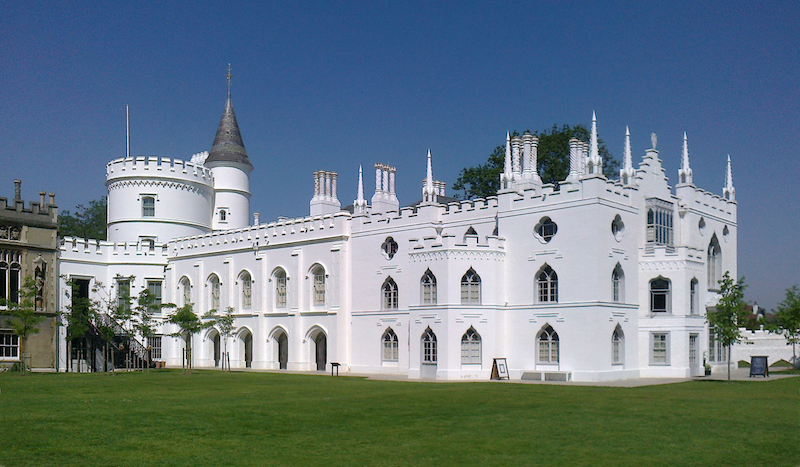In a notebook dated 1771 Horace Walpole imagined coming upon a ‘Grecian’ and a Gothic building, having never before encountered either style. Which, he asked himself, would he prefer? Since he connected ‘every inanimate thing with the idea of some person’, he would choose Gothic, because he would ‘prefer that building that furnished me with the most ideas, which is not judging fairly of the merit of the buildings abstractedly’.
In other words, Gothic appealed to Walpole because it was a style with associations, and ‘ideas’ for him outweighed judgements of buildings based on architectural standards alone. Anyone examining the popularity of Gothic in the time of Walpole might, therefore, be expected to ask what the associations were that made the style appealing in the 18th century. In an age of classicism, Gothic was a minority taste, so why did it attract the attention of significant patrons and leading architects and designers, from Christopher Wren to Robert Adam? It is puzzling that Peter N. Lindfield’s wide-ranging and lucidly written account of this understudied subject shows such little interest in answering these questions.
It’s only fairly recently that historians of 18th-century architecture and design in Britain have treated the Gothic Revival with full seriousness. To the Victorians, Georgian Gothic was an incompetent predecessor to their rediscovery of the style’s true principles. Twentieth-century critics, reacting against 19th-century historicism, inverted that judgement, praising ‘Gothick’ (as they liked to call it) for being whimsical and amusing. That attitude is still common today; Horace Walpole’s witty correspondence and the self-deprecating tone he often used about his ‘toy’ house have made it easy to assume that the Georgian Gothic revival as a whole was little more than a tease.
The obvious argument against this is that Strawberry Hill was far from being an isolated phenomenon. By starting the story in the 1730s (with a long glance backwards) and continuing into the early career of A.W.N. Pugin, Lindfield makes it plain that Gothic changed and developed through the period he discusses; he does not devote a single chapter to Strawberry Hill, but returns to it at key points in his narrative, tracing how Walpole’s Gothic evolved from a repertoire of ornament derived from pattern books to a style based on a study of medieval precedent. Lindfield makes the good point that criticism of Georgian Gothic as unscholarly was voiced in the 18th century as well as the 19th, not least by Walpole, and that the first person to make a distinction between true ‘Gothic’ and modern ‘Gothick’ was Batty Langley, whose invention in 1742 of the five Gothic ‘orders’ has provoked the disdain of almost everyone who writes on the Gothic revival.
Surprisingly, this includes Lindfield. He concedes that it was Langley’s prerogative as a designer to adapt his models, but criticises him for a ‘fanciful and almost entirely uninformed application of motifs taken out of historical context’. The way that Lindfield assesses every major designer he discusses in terms of their truthfulness to medieval precedent takes us back to Victorian judgements of Georgian Gothic. Wren’s Gothic buildings are ‘inescapably awkward and non-medieval in form structure and decoration’; Hawksmoor is chastised for mixing Gothic and classical motifs in a single building; William Kent for his ‘concentration on decorative effect rather than stylistic consistency and historical accuracy’, although no evidence is offered that he was concerned about such issues. Lindfield is oddly reluctant to acknowledge that these architects were treating Gothic as a style adaptable to modern requirements.
The sections that relate most closely to Lindfield’s specialism of furniture history, such as that on the furnishing of Eaton Hall, are much the strongest. It is surprising, however, that he has little to say about the collecting of antiquarian furnishings, such as armour and stained glass as well as old furniture. Approaching his subject primarily in terms of stylistic history, Lindfield addresses how the Gothic revival in the 18th century mixed ‘medieval motifs and forms with currently fashionable and accepted taste’. In consequence, he divides the period into three – a classical period of Gothic, exemplified by Kent, a rococo period, as seen in the Gothic designs in Chippendale’s Director, and a neoclassical or antiquarian period in the age of Adam. This is a reasonable approach, although such terms as rococo and neoclassical deserve more interrogation. Since rococo was identified as foreign, isn’t it interesting that in England it was so often fused with a style with nationalistic implications?
The question is not asked. The book never engages with the arguments of a whole generation of modern scholars about the meanings of Gothic architecture in the 18th century – its use to advertise social status or national identity, for example, or the importance of Freemasonry to Batty Langley, or the way that the style was deployed by the coterie centred on Walpole as a signifier of heterodox sexuality. Few historians would disagree that Gothic in the 18th century (as in the 16th, 17th, and 19th centuries) could carry political or religious implications, not least as a symbol of the frequently contested identity of the constitution and of the Church.
Yet Lindfield never discusses politics or religion, let alone issues of gender or sexuality. This is partly a consequence of some major unexplained absences from the book, notably the Gothic Temple at Stowe, which was designed to convey a political message, and the Countess of Oxford’s remodelling of Welbeck Abbey, which set an important precedent for a woman using Gothic to make a dynastic statement. Nonetheless, Lindfield’s footnotes and bibliography reveal an up-to-date knowledge of recent scholarship on his subject, which makes it baffling, as well as disappointing, that he has chosen to ignore it.
Georgian Gothic: Medievalist Architecture, Furniture and Interiors 1730–1840 by Peter N. Lindfield is published by Boydell Press (£50)
From the October issue of Apollo: preview and subscribe here
Lead image: used under Creative Commons licence (CC BY-SA 3.0)
Unlimited access from just $16 every 3 months
Subscribe to get unlimited and exclusive access to the top art stories, interviews and exhibition reviews.














![Masterpiece [Re]discovery 2022. Photo: Ben Fisher Photography, courtesy of Masterpiece London](http://www.apollo-magazine.com/wp-content/uploads/2022/07/MPL2022_4263.jpg)
It’s time for the government of London to return to its rightful home